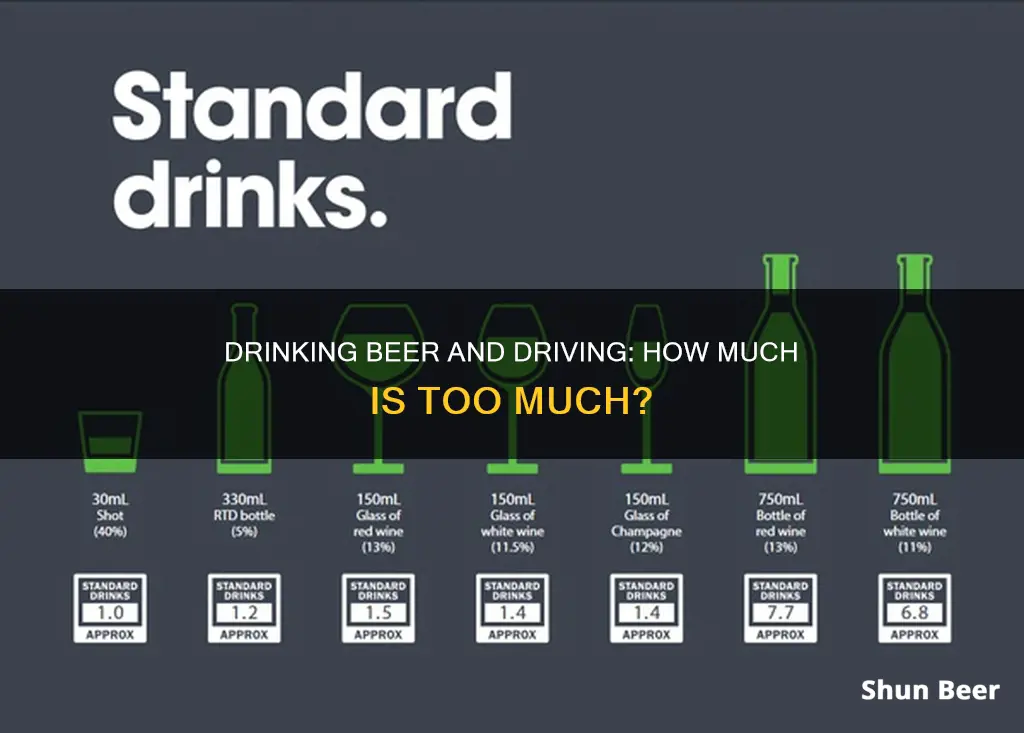
Drinking and driving is a dangerous combination that can lead to serious legal consequences and even cost lives. While the legal limit for Blood Alcohol Concentration (BAC) is .08% across all 50 states in the US, the number of beers one can consume and still drive varies depending on several factors. These include body weight, height, metabolism, food consumption, and the alcohol percentage of the beverage. While a 180-lb man may be able to consume 3.5 regular 12-ounce beers in an hour and stay under the legal limit, a 140-lb woman may only be able to consume 2.5. However, these are just estimates, and the safest option is to refrain from driving after drinking any amount of alcohol.
| Characteristics | Values |
|---|---|
| Number of beers | This varies depending on factors such as body size, weight, gender, metabolic rate, food consumption, and the ABV of the beer. |
| Legal blood alcohol content (BAC) limit | 0.08% |
| Metabolising alcohol | On average, it takes about one hour to metabolise one drink. This equates to 0.016 blood alcohol content per hour. |
| Time | The longer the time between drinking and driving, the lower the BAC will be. |
What You'll Learn

Factors that influence Blood Alcohol Concentration (BAC)
It is important to note that Blood Alcohol Concentration (BAC) is influenced by a variety of factors, and the amount of alcohol one can consume before being unfit to drive will vary from person to person. The only surefire way to stay under the BAC limit is to not drink at all. Here are some factors that influence BAC:
Number of Drinks and Time
The number of drinks consumed and the amount of time over which they are consumed are key factors in determining BAC. Generally, the body can process about one standard drink per hour. However, this can vary depending on individual factors.
Body Composition
Body composition, including weight, body fat percentage, and water content, can influence BAC. Alcohol is absorbed more slowly in people with higher body fat percentages since fat cells contain less water than muscle cells. As a result, alcohol tends to remain in the bloodstream until the liver breaks it down, potentially leading to higher BAC levels.
Sex Assigned at Birth
People assigned female at birth typically have a higher body fat percentage, lower water content, and lower levels of the enzyme that breaks down alcohol compared to people assigned male at birth. This means that alcohol will generally remain in their bloodstream for longer, resulting in higher BAC levels.
Food Consumption
Consuming alcohol on an empty stomach can cause the alcohol to be absorbed into the bloodstream more quickly, leading to a higher BAC. Eating a meal before drinking can slow down the absorption of alcohol, but it does not guarantee that you will be safe to drive.
Liver Function
The liver plays a crucial role in breaking down alcohol. Individuals with liver disease or liver damage may have impaired liver function, leading to a reduced ability to process alcohol efficiently. As a result, their BAC levels may be higher.
Age
Age can also impact BAC levels. As people age, their liver and water content may decrease in size, causing a slight decline in the body's ability to process alcohol effectively. Consequently, alcohol may remain in the bloodstream for longer, increasing BAC levels.
Enzyme Production and Levels
Enzyme production and levels can vary among individuals and are influenced by factors such as sex assigned at birth. Lower levels of the enzyme that breaks down alcohol will result in slower metabolism of alcohol, causing it to remain in the bloodstream for a longer period, leading to higher BAC levels.
Light Beer vs Regular Beer: Which is More Popular?
You may want to see also

Metabolising alcohol
Absorption of Alcohol
Alcohol is not digested like food. When swallowed, a small amount of alcohol is absorbed directly by the tongue and mucosal lining of the mouth. Once in the stomach, alcohol is quickly absorbed into the bloodstream through the tissue lining of the stomach and small intestine. The presence of food in the stomach can inhibit the absorption of alcohol in two ways: by physically blocking it from coming into contact with the stomach lining, and by preventing it from passing into the upper portion of the small intestine.
Distribution of Alcohol in the Body
Once alcohol is in the bloodstream, it is carried to all organs in the body. Blood circulates through the body in about 90 seconds, allowing alcohol to reach the brain and other organs rapidly. Alcohol enters all tissues of the body except bone and fat. The amount of alcohol distributed to different tissues depends on body composition.
Metabolism of Alcohol
The liver is the primary organ responsible for detoxifying alcohol. It releases enzymes to break down alcohol, but it can only process a small amount at a time, leaving the excess to circulate throughout the body. The enzymes alcohol dehydrogenase (ADH) and aldehyde dehydrogenase (ALDH) play a crucial role in breaking down the alcohol molecule. ADH metabolises alcohol into acetaldehyde, a highly toxic compound and known carcinogen. ALDH then further metabolises acetaldehyde into acetate, a less toxic compound. Finally, acetate is broken down into water and carbon dioxide, which can be easily eliminated from the body.
Factors Affecting Alcohol Metabolism
The rate at which alcohol is metabolised varies depending on several factors, including sex, age, food intake, weight, liver function, and individual genetic factors. Females tend to have a higher blood alcohol concentration (BAC) and eliminate alcohol faster than males. Younger and older individuals tend to eliminate alcohol more slowly. Food increases the metabolism rate, and alcohol metabolises faster at the end of the day. Exercise also slightly increases the elimination of alcohol. Additionally, heavy drinking can increase the metabolism rate, while advanced liver disease can decrease it.
Elimination of Alcohol
The body eliminates alcohol through various routes, including urine, breath, and sweat. Alcohol is volatile and can be eliminated through the breath when it comes into contact with air in the lungs. The liver's detoxification process also plays a crucial role in eliminating alcohol from the body. It's important to note that the rate of detoxification cannot be sped up, and drinking water or coffee will not accelerate this process.
Beer on the Chicago Metra: What's the Rule?
You may want to see also

Gender differences
Biological Factors:
- Body Composition: Women tend to have a higher percentage of body fat and lower water content than men, causing alcohol to be more concentrated in their blood, leading to higher blood alcohol levels even when consuming adjusted doses based on body weight.
- Alcohol Metabolism: Women eliminate alcohol from their bodies at a faster rate than men, which is influenced by factors such as liver volume and lean body mass.
- Cognitive Performance: Research suggests that women may experience greater cognitive impairment than men after consuming similar amounts of alcohol, particularly in tasks involving short-term memory, reaction time, and divided attention.
- Sensitivity to Alcohol: Men tend to have lower sensitivity to alcohol, requiring more alcohol to feel intoxicated. This can contribute to increased alcohol consumption and the development of tolerance over time.
Psychosocial and Cultural Influences:
- Socialization and Gender Roles: Traditional gender roles and expectations can influence drinking behaviors. Boys and men may drink more to conform to masculine ideals, while girls and women endorsing stereotypical female characteristics may report reduced alcohol consumption.
- Parental Influence: Parental modeling of alcohol use and parental monitoring can impact adolescent drinking. Parental monitoring tends to affect both boys and girls but may have a stronger influence on girls' drinking behaviors.
- Peer Influence: Affiliation with deviant peer groups and perceptions of peer drinking norms can contribute to increased alcohol consumption. Boys may have more freedom to interact with deviant peers, while girls may face stronger social sanctions against drinking.
- Psychiatric and Substance Use Comorbidity: Men are more likely to have alcohol use disorders without depression, while women are more likely to have depression without an alcohol use disorder. However, depression is a vulnerability factor for developing an alcohol use disorder in both genders.
Enjoying Beer on the Beach: What You Need to Know
You may want to see also

Weight differences
Weight plays a significant role in determining how much beer a person can drink and still drive. The general rule of thumb is that heavier individuals can consume more alcohol before becoming intoxicated, while those who are more slender or petite will reach the legal limit with fewer drinks.
For example, a 180-lb man may be able to drink 3.5 regular 12-ounce beers in an hour and maintain a Blood Alcohol Concentration (BAC) under the legal limit of 0.08%. On the other hand, a 140-lb woman may only be able to consume 2.5 regular beers in an hour and stay within the legal limit. These numbers are just estimates, however, and they assume that the average beer has a 5% alcohol by volume (ABV) level.
The relationship between weight and alcohol consumption is complex and influenced by various factors. Firstly, weight is linked to body composition, including muscle and fat densities, which can vary significantly between individuals. Secondly, weight can also impact metabolism, with heavier individuals potentially metabolizing alcohol at a faster rate than those with a lighter weight. This means that two people of different weights could consume the same amount of alcohol, but the heavier person may process it more quickly and be less affected.
It is important to remember that these are general trends, and individual factors, such as metabolic rate and tolerance, can also play a role in how alcohol is processed by the body. Additionally, the alcohol content of different beers can vary, with craft IPAs, stouts, and ales often having higher ABV levels. As a result, it is crucial to be mindful of the specific characteristics of the beer being consumed and to always err on the side of caution when drinking and driving.
Is Drinking Day-Old Beer Safe?
You may want to see also

Alcohol by volume (ABV)
The amount of beer you can drink and still drive depends on a variety of factors, including your weight, body type, age, sex, metabolism, and the amount of food you've consumed. The legal limit in almost every state in the US is a .08 blood alcohol concentration (BAC), meaning if your BAC is .08 or higher, you are considered legally impaired.
In general, one average drink will not put a driver over the limit of .08% BAC. Two regular drinks can be enough to put someone over the limit if they weigh less than 120 pounds. However, it's important to note that different drinks have different alcohol levels, and larger servings or higher alcohol content can increase a driver's BAC even if they are counting their drinks.
According to the California DMV BAC charts, one drink is defined as 12 ounces of a 5% beer. This means that a bottle of domestic beer would contain around .06 ounces of 100% alcohol. However, a pint of craft beer at 7% alcohol would contain about 1.12 ounces of alcohol, which is almost equivalent to two drinks.
It's worth noting that these charts are only estimates and do not consider all the factors that can affect BAC levels. The only way to truly ensure sobriety is to allow your body time to metabolize the alcohol. On average, the body reduces BAC by about .015% per hour. For example, a person with a BAC of .08% at 4:00 pm would likely have a BAC of about .05% two hours later, at 6:00 pm.
Drink Warm Beer? The Pros and Cons Explained
You may want to see also
Frequently asked questions
There is no one-size-fits-all answer to this question as it depends on various factors such as body weight, gender, metabolic rate, food consumption, and the alcohol percentage in the beer. However, as a general guideline, it is recommended that you do not drive if you have consumed alcohol and instead opt for alternative transportation options such as a taxi or public transport.
The legal limit for drinking and driving is typically determined by an individual's blood alcohol content (BAC). In most places, the legal limit is set at a BAC of 0.08%. However, it's important to note that you can still be charged with driving under the influence (DUI) if you are found to be impaired, even if your BAC is below the legal limit.
This depends on various factors, including the man's weight and the alcohol percentage in the beer. For example, a 200-pound man consuming two beers in an hour would have an estimated BAC of around 0.0266%, which is below the legal limit. On the other hand, a 150-pound man consuming the same amount of beer in an hour would have an estimated BAC of 0.0395%.
Similar to men, the number of beers a woman can drink and still be under the legal limit depends on factors such as weight and the alcohol percentage in the beer. For instance, a 100-pound woman consuming two beers in an hour would have a BAC of 0.0794%, which is just below the legal limit. A 130-pound woman consuming two beers in an hour would have a BAC of 0.0583%.
Drinking and driving can have serious and life-altering consequences. It can result in legal charges such as DUI, which can lead to jail time, fines, and a criminal record. It can also cause devastating accidents, injuries, and even fatalities. Drunk driving can shatter lives, ruin reputations, and permanently alter the future for both the victims and the driver.







